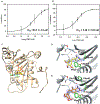Structural Insights into Mycobacterium tuberculosis Rv2671 Protein as a Dihydrofolate Reductase Functional Analogue Contributing to para-Aminosalicylic Acid Resistance
- PMID: 26848874
- PMCID: PMC6201685
- DOI: 10.1021/acs.biochem.5b00993
Structural Insights into Mycobacterium tuberculosis Rv2671 Protein as a Dihydrofolate Reductase Functional Analogue Contributing to para-Aminosalicylic Acid Resistance
Abstract
Mycobacterium tuberculosis (Mtb) Rv2671 is annotated as a 5-amino-6-ribitylamino-2,4(1H,3H)-pyrimidinedione 5'-phosphate (AROPP) reductase (RibD) in the riboflavin biosynthetic pathway. Recently, a strain of Mtb with a mutation in the 5' untranslated region of Rv2671, which resulted in its overexpression, was found to be resistant to dihydrofolate reductase (DHFR) inhibitors including the anti-Mtb drug para-aminosalicylic acid (PAS). In this study, a biochemical analysis of Rv2671 showed that it was able to catalyze the reduction of dihydrofolate (DHF) to tetrahydrofolate (THF), which explained why the overexpression of Rv2671 was sufficient to confer PAS resistance. We solved the structure of Rv2671 in complex with the NADP(+) and tetrahydrofolate (THF), which revealed the structural basis for the DHFR activity. The structures of Rv2671 complexed with two DHFR inhibitors, trimethoprim and trimetrexate, provided additional details of the substrate binding pocket and elucidated the differences between their inhibitory activities. Finally, Rv2671 was unable to catalyze the reduction of AROPP, which indicated that Rv2671 and its closely related orthologues are not involved in riboflavin biosynthesis.
Figures







Similar articles
-
para-Aminosalicylic acid is a prodrug targeting dihydrofolate reductase in Mycobacterium tuberculosis.J Biol Chem. 2013 Aug 9;288(32):23447-56. doi: 10.1074/jbc.M113.475798. Epub 2013 Jun 18. J Biol Chem. 2013. PMID: 23779105 Free PMC article.
-
E84G mutation in dihydrofolate reductase from drug resistant strains of Mycobacterium tuberculosis (Mumbai, India) leads to increased interaction with Trimethoprim.Int J Mycobacteriol. 2015 Jun;4(2):97-103. doi: 10.1016/j.ijmyco.2015.02.001. Epub 2015 Mar 13. Int J Mycobacteriol. 2015. PMID: 26972877
-
Mycobacterium tuberculosis dihydrofolate reductase reveals two conformational states and a possible low affinity mechanism to antifolate drugs.Structure. 2014 Jan 7;22(1):94-103. doi: 10.1016/j.str.2013.09.022. Epub 2013 Nov 7. Structure. 2014. PMID: 24210757
-
Recent Cutting-Edge Designing Strategies for Mtb-DHFR Inhibitors as Antitubercular Agents.Chem Biol Drug Des. 2024 Dec;104(6):e70027. doi: 10.1111/cbdd.70027. Chem Biol Drug Des. 2024. PMID: 39660864 Review.
-
Dihydrofolate reductase inhibitors for use as antimicrobial agents.Eur J Med Chem. 2020 Jun 1;195:112268. doi: 10.1016/j.ejmech.2020.112268. Epub 2020 Apr 1. Eur J Med Chem. 2020. PMID: 32298876 Review.
Cited by
-
Polypharmacology-Driven Discovery and Design of Highly Selective, Dual and Multitargeting Inhibitors of Mycobacterium tuberculosis - A Review.Curr Drug Targets. 2024;25(9):620-634. doi: 10.2174/0113894501306302240526160804. Curr Drug Targets. 2024. PMID: 38859782 Review.
-
Deletion of sigB Causes Increased Sensitivity to para-Aminosalicylic Acid and Sulfamethoxazole in Mycobacterium tuberculosis.Antimicrob Agents Chemother. 2017 Sep 22;61(10):e00551-17. doi: 10.1128/AAC.00551-17. Print 2017 Oct. Antimicrob Agents Chemother. 2017. PMID: 28717039 Free PMC article.
-
Competition between H4PteGlu and H2PtePAS Confers para-Aminosalicylic Acid Resistance in Mycobacterium tuberculosis.Antibiotics (Basel). 2023 Dec 21;13(1):13. doi: 10.3390/antibiotics13010013. Antibiotics (Basel). 2023. PMID: 38275323 Free PMC article.
-
The T120P or M172V mutation on rv2172c confers high level para-aminosalicylic acid resistance in Mycobacterium tuberculosis.Emerg Microbes Infect. 2024 Dec;13(1):2374030. doi: 10.1080/22221751.2024.2374030. Epub 2024 Jul 24. Emerg Microbes Infect. 2024. PMID: 39023395 Free PMC article.
-
The aminosalicylate - folate connection.Drug Metab Rev. 2024 Feb;56(1):80-96. doi: 10.1080/03602532.2024.2303507. Epub 2024 Jan 17. Drug Metab Rev. 2024. PMID: 38230664 Free PMC article. Review.
References
-
- CDC. Update: Availability of Streptomycin and para-Amino-salicylic Acid—United States, Morbidity and Mortality Weekly Report; 41, 26; Center for Disease Control and Prevention: Atlanta, GA, 1992; 482.
-
- Rieckmann KH (1973) The in Vitro Activity of Experimental Antimalarial Compounds against Strains of Plasmodium falciparum with Varying Degrees of Sensitivity to Pyrimethamine and Chloroquine, in Chemotherapy of Malaria and Resistance to Antimalarials, 529th ed., p 58, WHO Tech. Rep. Ser., World Health Organization, Geneva, Switzerland.
Publication types
MeSH terms
Substances
Grants and funding
LinkOut - more resources
Full Text Sources
Other Literature Sources

